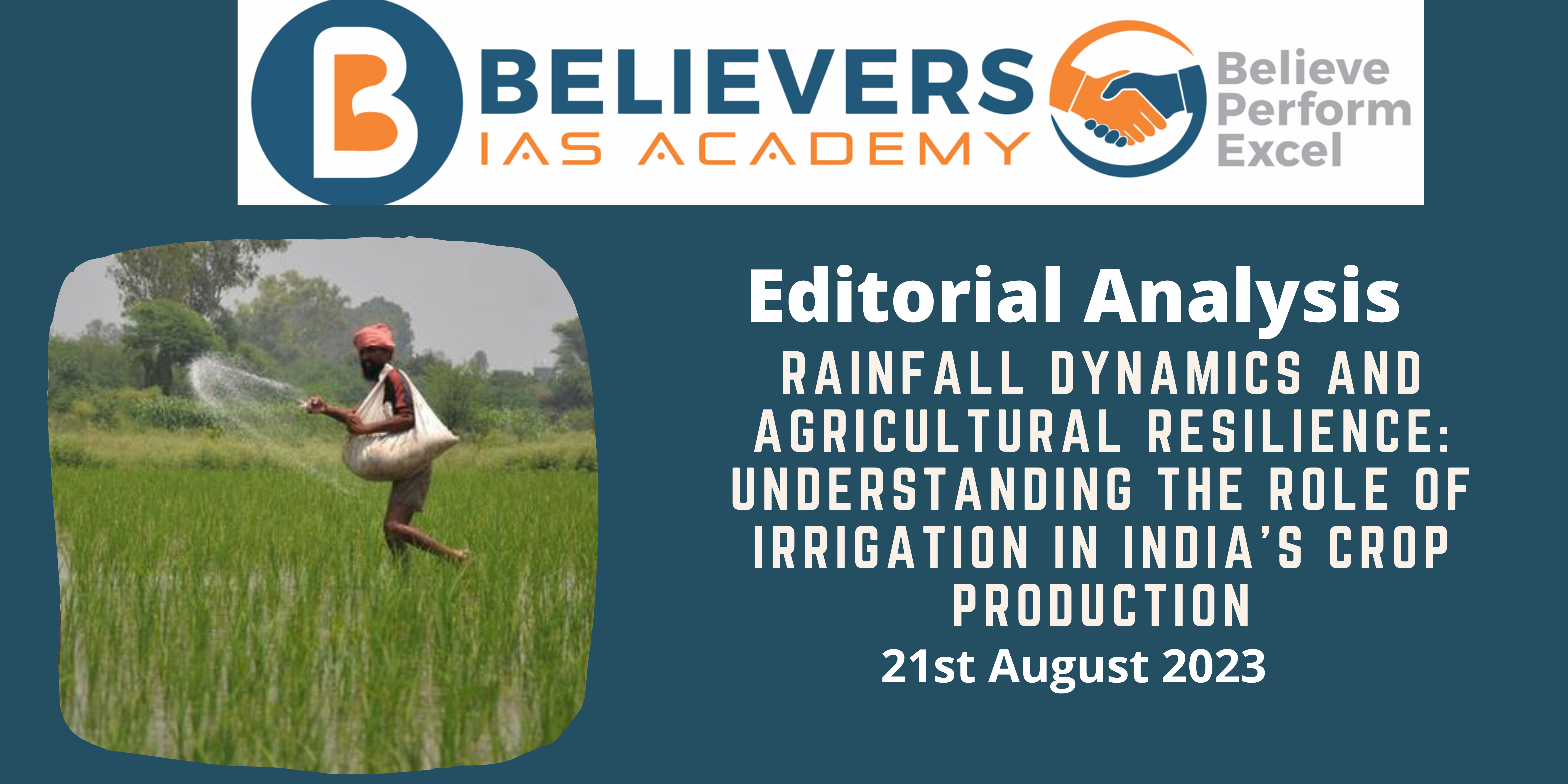Rainfall Dynamics and Agricultural Resilience: Understanding the Role of Irrigation in India’s Crop Production
Context:
Recent reports and experts are raising concerns about India’s exceptionally dry August, which could be the driest in a century. Data reveals a 7% deficit in cumulative monsoon rainfall compared to the long-term average. This predicament is anticipated to worsen, with estimates suggesting that this August might witness the lowest rainfall since records began in 1901. This situation’s repercussions are already apparent in the reduced sowing of kharif crops, particularly pulses, which have declined by 10% compared to the previous year. The potential consequence of this scarcity is the further escalation of food prices, given the substantial inflation of pulses, notably toor dal, which registered a 34% increase in July.
Relevance:
GS-01 (Physical Geography)
GS-03 (Indian Economy)
Prelims:
- Agricultural productivity
- Cropping patterns and major crops in India
- Inflation
Mains Question:
- Discuss the impact of changing rainfall patterns on agricultural practices in India, considering historical dependence on the monsoon and the role of irrigation improvements. (150 words)
Dimensions of the Article:
- The Interplay of Rainfall and Agricultural Outcomes
- Evolution of Irrigation and Crop Production
- State-Wise Irrigation Changes
- Rainfall and Rice Production in Less Irrigated States
- Rainfall and Foodgrains Production in Well-Irrigated States
The Interplay of Rainfall and Agricultural Outcomes:
- India’s agricultural success has long been intertwined with the southwest monsoon. A recent paper highlighted in the Reserve Bank of India’s August bulletin dives into the evolving nature of this reliance and how the expansion of irrigation infrastructure has influenced this dynamic.
- While the monsoon remains pivotal for both kharif and rabi crops, there has been a diminishing reliance on it in recent years. Notably, the regions experiencing improved irrigation coverage have experienced a milder impact from erratic monsoon patterns.
Evolution of Irrigation and Crop Production:
- A graphical representation, Chart 1, illustrates the connection between rainfall deviation from the long-term average and changes in foodgrains production. Intriguingly, despite four out of six years since 2016 observing below-average rainfall (as denoted in the graph), foodgrains and rice production have exhibited consistent growth.
- This shift in trend could be attributed to states progressively enhancing their irrigation coverage over time.
State-Wise Irrigation Changes:
- Chart 2 provides a comprehensive view of the percentage of net sown area that is irrigated in various states, comparing 1990 and 2020.
- The data demonstrates significant growth in the share of irrigated areas in most states over the past two decades.
- Remarkably, in 2020, nine out of 17 major states had more than half of their net sown area irrigated, a remarkable upswing from merely three states in 1990.
Rainfall and Rice Production in Less Irrigated States:
- Examining the last three decades, Chart 3 juxtaposes rainfall deviations from the long-term average and changes in rice production in states with limited irrigation like Assam, Karnataka, Madhya Pradesh, Maharashtra, and Odisha.
- Each data point corresponds to a specific state-year pair, such as 2000-Assam or 1995-Karnataka. In states with inadequate irrigation (where the net irrigated area constituted less than 40% of the net sown area), rice production typically plummeted during periods of insufficient rainfall.
- The chart reveals a clear correlation, as circles in the lower-left quadrant indicate low production aligned with low rainfall.
Rainfall and Foodgrains Production in Well-Irrigated States:
- Chart 4 scrutinizes the relationship between rainfall deviations and changes in foodgrains production in states with superior irrigation like Haryana, Punjab, Tamil Nadu, Uttar Pradesh, and West Bengal.
- In these states, characterized by robust irrigation coverage (where over 40% of the net sown area is irrigated), rice production often demonstrated resilience, even during phases of inadequate rainfall.
Way Forward:
- The evidence presented underscores the necessity of further enhancing irrigation infrastructure to mitigate the detrimental consequences of erratic monsoon patterns on crop production. Strengthening irrigation systems can act as a buffer against the negative effects of insufficient rainfall, fostering a more stable agricultural landscape.
Conclusion:
- The juxtaposition of rainfall patterns and crop production across states provides a nuanced understanding of the evolving dynamics in India’s agriculture. As demonstrated, improved irrigation coverage plays a pivotal role in minimizing the adverse impact of irregular monsoon patterns.
- The implications are clear: investing in irrigation infrastructure emerges as a critical strategy to ensure food security and sustainable agricultural growth in the face of uncertain climatic conditions.
Source: The Hindu




